特征选择
- 格式:pdf
- 大小:253.63 KB
- 文档页数:7
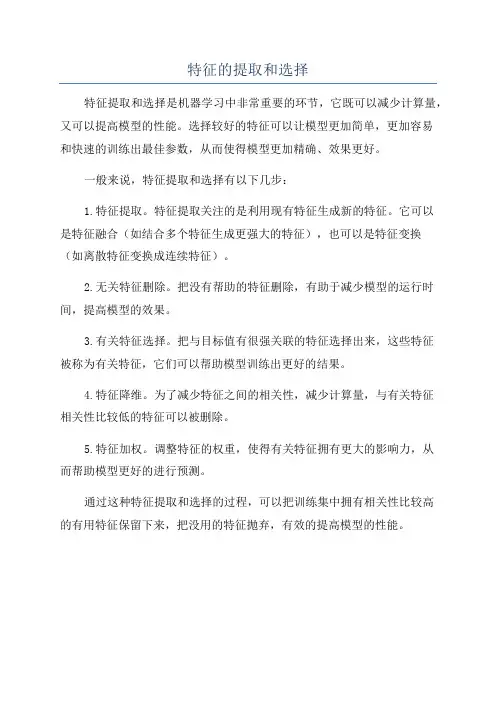
特征的提取和选择
特征提取和选择是机器学习中非常重要的环节,它既可以减少计算量,又可以提高模型的性能。
选择较好的特征可以让模型更加简单,更加容易
和快速的训练出最佳参数,从而使得模型更加精确、效果更好。
一般来说,特征提取和选择有以下几步:
1.特征提取。
特征提取关注的是利用现有特征生成新的特征。
它可以
是特征融合(如结合多个特征生成更强大的特征),也可以是特征变换
(如离散特征变换成连续特征)。
2.无关特征删除。
把没有帮助的特征删除,有助于减少模型的运行时间,提高模型的效果。
3.有关特征选择。
把与目标值有很强关联的特征选择出来,这些特征
被称为有关特征,它们可以帮助模型训练出更好的结果。
4.特征降维。
为了减少特征之间的相关性,减少计算量,与有关特征
相关性比较低的特征可以被删除。
5.特征加权。
调整特征的权重,使得有关特征拥有更大的影响力,从
而帮助模型更好的进行预测。
通过这种特征提取和选择的过程,可以把训练集中拥有相关性比较高
的有用特征保留下来,把没用的特征抛弃,有效的提高模型的性能。
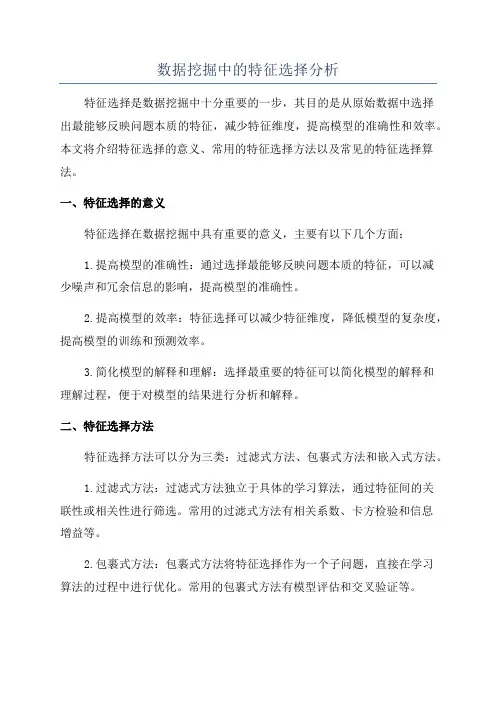
数据挖掘中的特征选择分析特征选择是数据挖掘中十分重要的一步,其目的是从原始数据中选择出最能够反映问题本质的特征,减少特征维度,提高模型的准确性和效率。
本文将介绍特征选择的意义、常用的特征选择方法以及常见的特征选择算法。
一、特征选择的意义特征选择在数据挖掘中具有重要的意义,主要有以下几个方面:1.提高模型的准确性:通过选择最能够反映问题本质的特征,可以减少噪声和冗余信息的影响,提高模型的准确性。
2.提高模型的效率:特征选择可以减少特征维度,降低模型的复杂度,提高模型的训练和预测效率。
3.简化模型的解释和理解:选择最重要的特征可以简化模型的解释和理解过程,便于对模型的结果进行分析和解释。
二、特征选择方法特征选择方法可以分为三类:过滤式方法、包裹式方法和嵌入式方法。
1.过滤式方法:过滤式方法独立于具体的学习算法,通过特征间的关联性或相关性进行筛选。
常用的过滤式方法有相关系数、卡方检验和信息增益等。
2.包裹式方法:包裹式方法将特征选择作为一个子问题,直接在学习算法的过程中进行优化。
常用的包裹式方法有模型评估和交叉验证等。
3.嵌入式方法:嵌入式方法将特征选择融入到学习算法中,在学习过程中自动选择特征。
常用的嵌入式方法有L1正则化和决策树剪枝等。
三、特征选择算法1.相关系数:相关系数衡量两个变量之间的关联性,可用于过滤式方法。
相关系数的绝对值越大,表示两个变量之间的关联性越强。
2.卡方检验:卡方检验用于衡量特征与目标变量之间的相关性,可用于过滤式方法。
卡方值越大,表示特征与目标变量之间的相关性越强。
3.信息增益:信息增益用于衡量特征对于目标变量的贡献,可用于过滤式方法。
信息增益越大,表示特征对于目标变量的贡献越大。
4.L1正则化:L1正则化是一种嵌入式方法,在模型训练过程中自动选择特征。
L1正则化通过增加L1范数作为正则化项,使得部分特征的权重变为0,实现特征选择的效果。
5.决策树剪枝:决策树剪枝是一种嵌入式方法,通过裁剪决策树的叶子节点来选择特征。
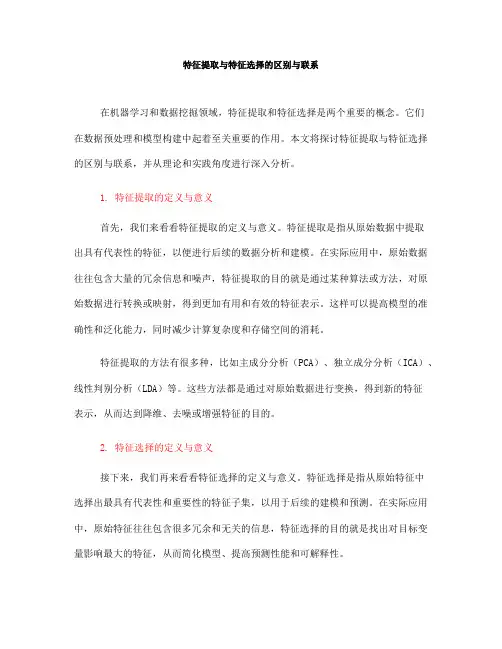
特征提取与特征选择的区别与联系在机器学习和数据挖掘领域,特征提取和特征选择是两个重要的概念。
它们在数据预处理和模型构建中起着至关重要的作用。
本文将探讨特征提取与特征选择的区别与联系,并从理论和实践角度进行深入分析。
1. 特征提取的定义与意义首先,我们来看看特征提取的定义与意义。
特征提取是指从原始数据中提取出具有代表性的特征,以便进行后续的数据分析和建模。
在实际应用中,原始数据往往包含大量的冗余信息和噪声,特征提取的目的就是通过某种算法或方法,对原始数据进行转换或映射,得到更加有用和有效的特征表示。
这样可以提高模型的准确性和泛化能力,同时减少计算复杂度和存储空间的消耗。
特征提取的方法有很多种,比如主成分分析(PCA)、独立成分分析(ICA)、线性判别分析(LDA)等。
这些方法都是通过对原始数据进行变换,得到新的特征表示,从而达到降维、去噪或增强特征的目的。
2. 特征选择的定义与意义接下来,我们再来看看特征选择的定义与意义。
特征选择是指从原始特征中选择出最具有代表性和重要性的特征子集,以用于后续的建模和预测。
在实际应用中,原始特征往往包含很多冗余和无关的信息,特征选择的目的就是找出对目标变量影响最大的特征,从而简化模型、提高预测性能和可解释性。
特征选择的方法有很多种,比如过滤式、包裹式和嵌入式等。
过滤式方法是直接对特征进行评估和排序,选择最高分的特征子集;包裹式方法是把特征选择看作一个搜索问题,通过试验不同的特征子集来找到最佳组合;嵌入式方法则是在模型训练过程中,通过正则化或增加惩罚项的方式来选择特征。
3. 特征提取与特征选择的区别特征提取与特征选择虽然都是对原始数据或特征进行处理,但它们在目的和方法上有着明显的区别。
首先,特征提取是通过某种变换或映射,得到新的特征表示,目的是降维、去噪或增强特征;而特征选择是从原始特征中选择出最具有代表性和重要性的特征子集,目的是简化模型、提高预测性能和可解释性。
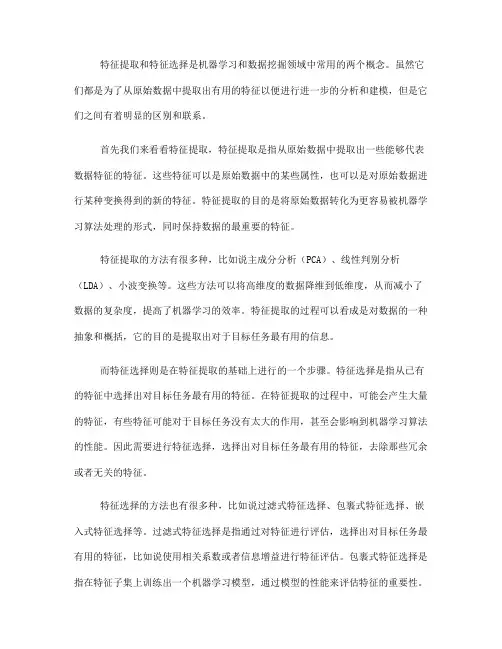
特征提取和特征选择是机器学习和数据挖掘领域中常用的两个概念。
虽然它们都是为了从原始数据中提取出有用的特征以便进行进一步的分析和建模,但是它们之间有着明显的区别和联系。
首先我们来看看特征提取,特征提取是指从原始数据中提取出一些能够代表数据特征的特征。
这些特征可以是原始数据中的某些属性,也可以是对原始数据进行某种变换得到的新的特征。
特征提取的目的是将原始数据转化为更容易被机器学习算法处理的形式,同时保持数据的最重要的特征。
特征提取的方法有很多种,比如说主成分分析(PCA)、线性判别分析(LDA)、小波变换等。
这些方法可以将高维度的数据降维到低维度,从而减小了数据的复杂度,提高了机器学习的效率。
特征提取的过程可以看成是对数据的一种抽象和概括,它的目的是提取出对于目标任务最有用的信息。
而特征选择则是在特征提取的基础上进行的一个步骤。
特征选择是指从已有的特征中选择出对目标任务最有用的特征。
在特征提取的过程中,可能会产生大量的特征,有些特征可能对于目标任务没有太大的作用,甚至会影响到机器学习算法的性能。
因此需要进行特征选择,选择出对目标任务最有用的特征,去除那些冗余或者无关的特征。
特征选择的方法也有很多种,比如说过滤式特征选择、包裹式特征选择、嵌入式特征选择等。
过滤式特征选择是指通过对特征进行评估,选择出对目标任务最有用的特征,比如说使用相关系数或者信息增益进行特征评估。
包裹式特征选择是指在特征子集上训练出一个机器学习模型,通过模型的性能来评估特征的重要性。
嵌入式特征选择则是指在模型训练的过程中自动选择出对目标任务最有用的特征,比如说使用正则化方法。
特征提取和特征选择在实际应用中经常会同时进行,它们之间有着很大的联系。
特征提取会产生大量的特征,在特征选择的过程中,有时候也需要对特征进行一些变换和组合。
比如说,在包裹式特征选择的过程中,需要对特征子集进行训练,可能需要将特征进行某种组合,而这个过程有点类似于特征提取。
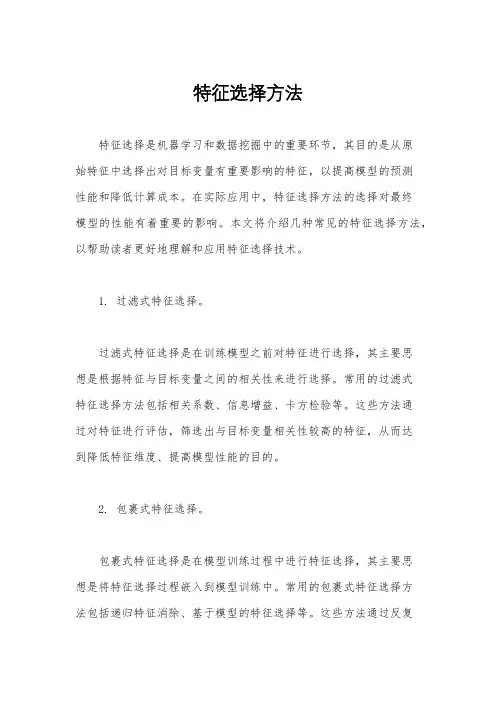
特征选择方法特征选择是机器学习和数据挖掘中的重要环节,其目的是从原始特征中选择出对目标变量有重要影响的特征,以提高模型的预测性能和降低计算成本。
在实际应用中,特征选择方法的选择对最终模型的性能有着重要的影响。
本文将介绍几种常见的特征选择方法,以帮助读者更好地理解和应用特征选择技术。
1. 过滤式特征选择。
过滤式特征选择是在训练模型之前对特征进行选择,其主要思想是根据特征与目标变量之间的相关性来进行选择。
常用的过滤式特征选择方法包括相关系数、信息增益、卡方检验等。
这些方法通过对特征进行评估,筛选出与目标变量相关性较高的特征,从而达到降低特征维度、提高模型性能的目的。
2. 包裹式特征选择。
包裹式特征选择是在模型训练过程中进行特征选择,其主要思想是将特征选择过程嵌入到模型训练中。
常用的包裹式特征选择方法包括递归特征消除、基于模型的特征选择等。
这些方法通过反复训练模型并调整特征集合,最终选择出对模型性能影响最大的特征组合。
3. 嵌入式特征选择。
嵌入式特征选择是在模型训练过程中自动地进行特征选择,其主要思想是将特征选择过程融入到模型参数的学习过程中。
常用的嵌入式特征选择方法包括L1正则化、决策树剪枝等。
这些方法通过在模型训练过程中对特征进行惩罚或剪枝,从而实现特征选择的目的。
4. 混合式特征选择。
混合式特征选择是将多种特征选择方法进行组合,以充分利用各种方法的优势。
常用的混合式特征选择方法包括特征重要性评估、特征组合搜索等。
这些方法通过综合考虑不同特征选择方法的结果,选择出对模型性能影响最大的特征集合。
在实际应用中,特征选择方法的选择应根据具体问题的特点和数据的特征来进行。
需要注意的是,特征选择过程应该是一个迭代的过程,需要不断地尝试不同的方法和参数,以找到最优的特征集合。
另外,特征选择方法的选择也需要考虑到模型的类型和性能指标,以确保选择出的特征集合能够在实际应用中发挥最大的作用。
总之,特征选择是机器学习和数据挖掘中至关重要的一环,其选择方法的合理性和有效性直接影响着最终模型的性能。
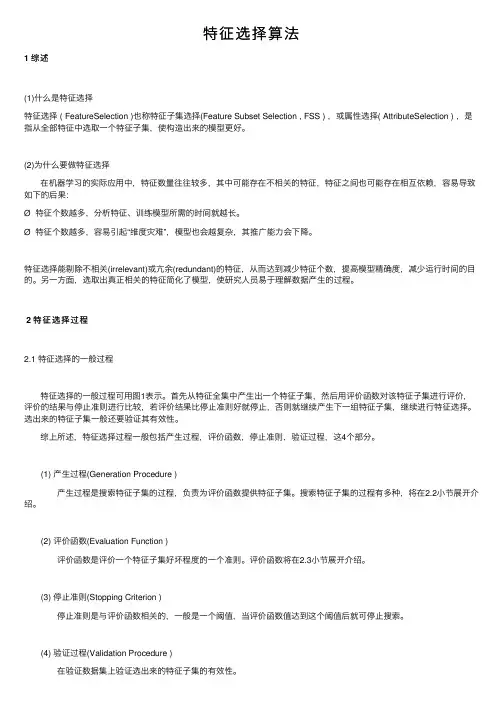
特征选择算法1 综述(1)什么是特征选择特征选择 ( FeatureSelection )也称特征⼦集选择(Feature Subset Selection , FSS ) ,或属性选择( AttributeSelection ) ,是指从全部特征中选取⼀个特征⼦集,使构造出来的模型更好。
(2)为什么要做特征选择在机器学习的实际应⽤中,特征数量往往较多,其中可能存在不相关的特征,特征之间也可能存在相互依赖,容易导致如下的后果:Ø 特征个数越多,分析特征、训练模型所需的时间就越长。
Ø 特征个数越多,容易引起“维度灾难”,模型也会越复杂,其推⼴能⼒会下降。
特征选择能剔除不相关(irrelevant)或亢余(redundant)的特征,从⽽达到减少特征个数,提⾼模型精确度,减少运⾏时间的⽬的。
另⼀⽅⾯,选取出真正相关的特征简化了模型,使研究⼈员易于理解数据产⽣的过程。
2 特征选择过程2.1 特征选择的⼀般过程特征选择的⼀般过程可⽤图1表⽰。
⾸先从特征全集中产⽣出⼀个特征⼦集,然后⽤评价函数对该特征⼦集进⾏评价,评价的结果与停⽌准则进⾏⽐较,若评价结果⽐停⽌准则好就停⽌,否则就继续产⽣下⼀组特征⼦集,继续进⾏特征选择。
选出来的特征⼦集⼀般还要验证其有效性。
综上所述,特征选择过程⼀般包括产⽣过程,评价函数,停⽌准则,验证过程,这4个部分。
(1) 产⽣过程(Generation Procedure ) 产⽣过程是搜索特征⼦集的过程,负责为评价函数提供特征⼦集。
搜索特征⼦集的过程有多种,将在2.2⼩节展开介绍。
(2) 评价函数(Evaluation Function ) 评价函数是评价⼀个特征⼦集好坏程度的⼀个准则。
评价函数将在2.3⼩节展开介绍。
(3) 停⽌准则(Stopping Criterion ) 停⽌准则是与评价函数相关的,⼀般是⼀个阈值,当评价函数值达到这个阈值后就可停⽌搜索。
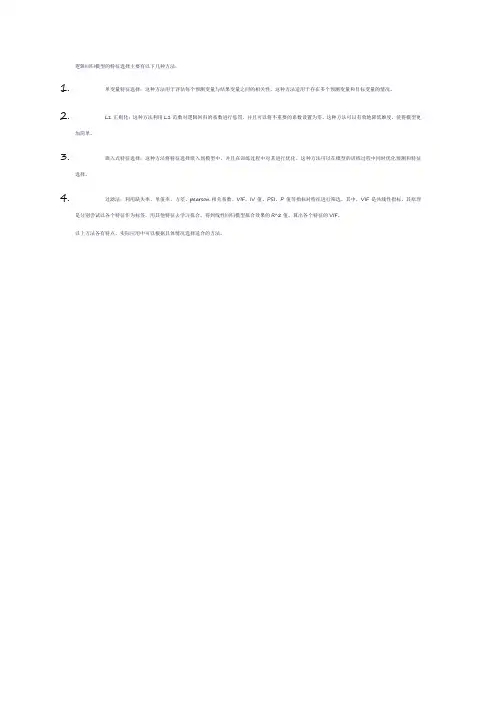
逻辑回归模型的特征选择主要有以下几种方法:
1.单变量特征选择:这种方法用于评估每个预测变量与结果变量之间的相关性。
这种方法适用于存在多个预测变量和目标变量的情况。
2.L1正则化:这种方法利用L1范数对逻辑回归的系数进行惩罚,并且可以将不重要的系数设置为零。
这种方法可以有效地降低维度,使得模型更
加简单。
3.嵌入式特征选择:这种方法将特征选择嵌入到模型中,并且在训练过程中对其进行优化。
这种方法可以在模型的训练过程中同时优化预测和特征
选择。
4.过滤法:利用缺失率、单值率、方差、pearson相关系数、VIF、IV值、PSI、P值等指标对特征进行筛选。
其中,VIF是共线性指标,其原理
是分别尝试以各个特征作为标签,用其他特征去学习拟合,得到线性回归模型拟合效果的R^2值,算出各个特征的VIF。
以上方法各有特点,实际应用中可以根据具体情况选择适合的方法。
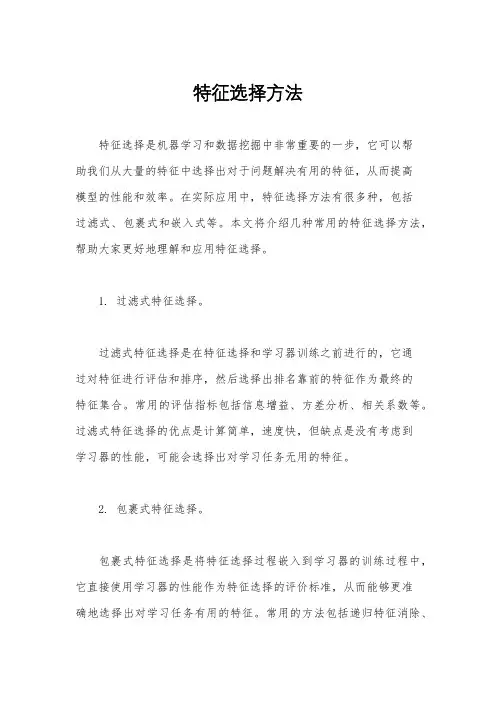
特征选择方法特征选择是机器学习和数据挖掘中非常重要的一步,它可以帮助我们从大量的特征中选择出对于问题解决有用的特征,从而提高模型的性能和效率。
在实际应用中,特征选择方法有很多种,包括过滤式、包裹式和嵌入式等。
本文将介绍几种常用的特征选择方法,帮助大家更好地理解和应用特征选择。
1. 过滤式特征选择。
过滤式特征选择是在特征选择和学习器训练之前进行的,它通过对特征进行评估和排序,然后选择出排名靠前的特征作为最终的特征集合。
常用的评估指标包括信息增益、方差分析、相关系数等。
过滤式特征选择的优点是计算简单,速度快,但缺点是没有考虑到学习器的性能,可能会选择出对学习任务无用的特征。
2. 包裹式特征选择。
包裹式特征选择是将特征选择过程嵌入到学习器的训练过程中,它直接使用学习器的性能作为特征选择的评价标准,从而能够更准确地选择出对学习任务有用的特征。
常用的方法包括递归特征消除、基于模型的特征选择等。
包裹式特征选择的优点是能够充分考虑学习器的性能,但缺点是计算复杂,速度较慢。
3. 嵌入式特征选择。
嵌入式特征选择是将特征选择过程嵌入到学习器的训练过程中,它通过正则化方法或者模型参数的学习来选择出对学习任务有用的特征。
常用的方法包括L1正则化、决策树剪枝等。
嵌入式特征选择的优点是能够充分考虑学习器的性能,计算相对较快,但缺点是可能会受到学习器类型的限制。
在实际应用中,选择合适的特征选择方法非常重要,需要根据具体的问题和数据集来进行选择。
有时候也可以结合多种特征选择方法来进行特征选择,以达到更好的效果。
另外,特征选择并不是一劳永逸的过程,随着数据的变化和问题的演化,特征选择也需要不断地进行调整和优化。
总结而言,特征选择是机器学习和数据挖掘中非常重要的一步,它可以帮助我们提高模型的性能和效率。
常用的特征选择方法包括过滤式、包裹式和嵌入式特征选择,每种方法都有其优点和局限性,需要根据具体情况进行选择和调整。
希望本文介绍的内容能够帮助大家更好地理解和应用特征选择方法,提高数据分析和建模的能力。
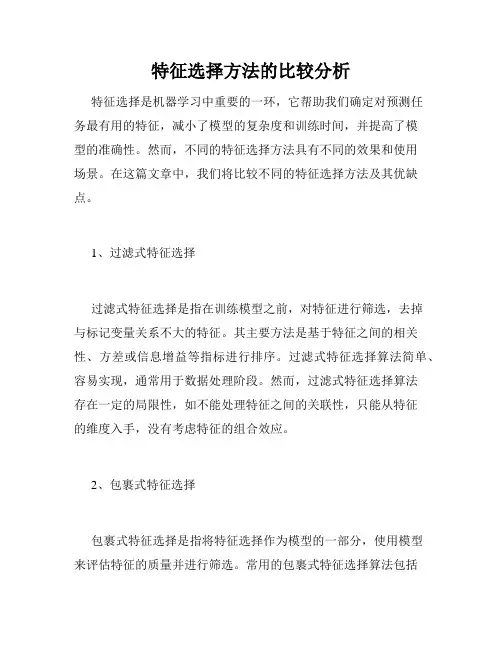
特征选择方法的比较分析特征选择是机器学习中重要的一环,它帮助我们确定对预测任务最有用的特征,减小了模型的复杂度和训练时间,并提高了模型的准确性。
然而,不同的特征选择方法具有不同的效果和使用场景。
在这篇文章中,我们将比较不同的特征选择方法及其优缺点。
1、过滤式特征选择过滤式特征选择是指在训练模型之前,对特征进行筛选,去掉与标记变量关系不大的特征。
其主要方法是基于特征之间的相关性、方差或信息增益等指标进行排序。
过滤式特征选择算法简单、容易实现,通常用于数据处理阶段。
然而,过滤式特征选择算法存在一定的局限性,如不能处理特征之间的关联性,只能从特征的维度入手,没有考虑特征的组合效应。
2、包裹式特征选择包裹式特征选择是指将特征选择作为模型的一部分,使用模型来评估特征的质量并进行筛选。
常用的包裹式特征选择算法包括递归特征消除和基于遗传算法的特征选择。
包裹式特征选择算法通常可以更准确地筛选出对模型最有用的特征,但是计算成本更高,训练时间更长。
3、嵌入式特征选择嵌入式特征选择是指将特征选择嵌入到机器学习的建模过程中,例如Lasso回归、Elastic Net等。
嵌入式特征选择算法可以同时进行特征选择和模型训练,具有较高的效率,而且可以在特征之间建立有效的关系,更好地利用特征信息。
然而,嵌入式特征选择算法需要评估每个特征的权重和影响,计算量比过滤和包裹式特征选择算法更大。
4、基于深度学习的特征选择随着深度学习的发展,它在特征提取和特征选择方面的应用越来越广泛。
基于深度学习的特征选择算法可以利用神经网络分层结构对特征进行自动提取和筛选,其主要方法包括Autoencoder、Deep Belief Networks和Convolutional Neural Networks。
这些算法在大数据集合和高维数据中表现良好,可以挖掘出更丰富的特征,但是需要更大的计算资源和更长的训练时间。
总的来说,不同的特征选择算法有各自的优劣和使用限制,需要根据实际的数据和任务需求进行选择。
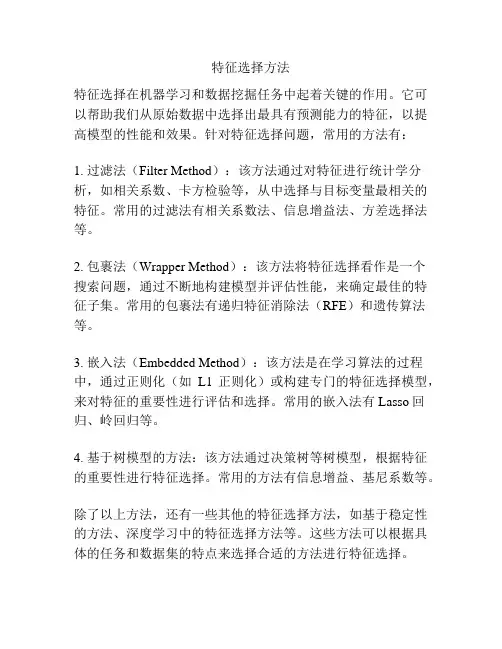
特征选择方法
特征选择在机器学习和数据挖掘任务中起着关键的作用。
它可以帮助我们从原始数据中选择出最具有预测能力的特征,以提高模型的性能和效果。
针对特征选择问题,常用的方法有:
1. 过滤法(Filter Method):该方法通过对特征进行统计学分析,如相关系数、卡方检验等,从中选择与目标变量最相关的特征。
常用的过滤法有相关系数法、信息增益法、方差选择法等。
2. 包裹法(Wrapper Method):该方法将特征选择看作是一个
搜索问题,通过不断地构建模型并评估性能,来确定最佳的特征子集。
常用的包裹法有递归特征消除法(RFE)和遗传算法等。
3. 嵌入法(Embedded Method):该方法是在学习算法的过程中,通过正则化(如L1正则化)或构建专门的特征选择模型,来对特征的重要性进行评估和选择。
常用的嵌入法有Lasso回归、岭回归等。
4. 基于树模型的方法:该方法通过决策树等树模型,根据特征的重要性进行特征选择。
常用的方法有信息增益、基尼系数等。
除了以上方法,还有一些其他的特征选择方法,如基于稳定性的方法、深度学习中的特征选择方法等。
这些方法可以根据具体的任务和数据集的特点来选择合适的方法进行特征选择。
特征选择的目的是为了去除无关特征、降低数据维度以及提高模型性能等。
正确选择合适的特征选择方法,可以帮助我们更好地理解数据并提高模型的预测能力。
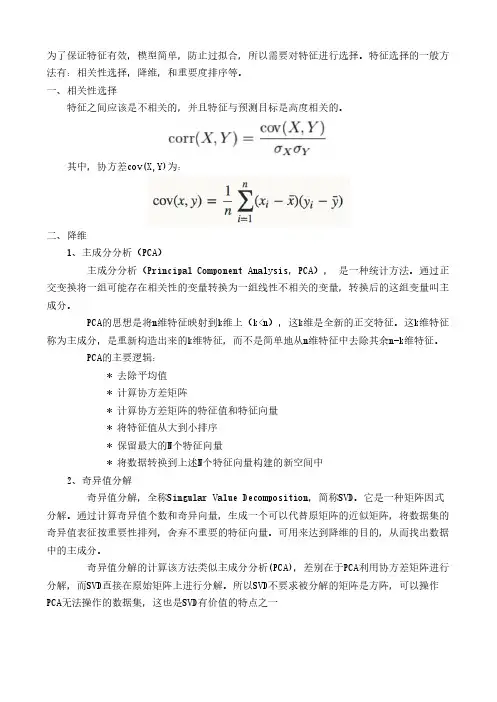
为了保证特征有效,模型简单,防止过拟合,所以需要对特征进行选择。
特征选择的一般方法有:相关性选择,降维,和重要度排序等。
一、相关性选择特征之间应该是不相关的,并且特征与预测目标是高度相关的。
其中,协方差cov(X,Y)为:二、降维1、主成分分析(PCA)主成分分析(Principal Component Analysis,PCA), 是一种统计方法。
通过正交变换将一组可能存在相关性的变量转换为一组线性不相关的变量,转换后的这组变量叫主成分。
PCA的思想是将n维特征映射到k维上(k<n),这k维是全新的正交特征。
这k维特征称为主成分,是重新构造出来的k维特征,而不是简单地从n维特征中去除其余n-k维特征。
PCA的主要逻辑:* 去除平均值* 计算协方差矩阵* 计算协方差矩阵的特征值和特征向量* 将特征值从大到小排序* 保留最大的N个特征向量* 将数据转换到上述N个特征向量构建的新空间中2、奇异值分解奇异值分解,全称Singular Value Decomposition,简称SVD。
它是一种矩阵因式分解。
通过计算奇异值个数和奇异向量,生成一个可以代替原矩阵的近似矩阵,将数据集的奇异值表征按重要性排列,舍弃不重要的特征向量。
可用来达到降维的目的,从而找出数据中的主成分。
奇异值分解的计算该方法类似主成分分析(PCA),差别在于PCA利用协方差矩阵进行分解,而SVD直接在原始矩阵上进行分解。
所以SVD不要求被分解的矩阵是方阵,可以操作PCA无法操作的数据集,这也是SVD有价值的特点之一三、特征重要度排序特征重要度排序主要有三种方法:过滤法,包装法、嵌入法。
a、过滤法:按照发散性或者相关性对各个特征进行评分,设定阈值或者待选择阈值的个数,选择特征。
方差选择法:计算各个特征方差,选择方差大于阈值的特征。
当特征值都是离散型变量的时候这种方法才能用,如果是连续型变量,就需要将连续变量离散化之后才能用。
可以把它作为特征选择的预处理,先去掉那些取值变化小的特征,然后再从接下来提到的的特征选择方法中选择合适的进行进一步的特征选择。
特征提取与特征选择是机器学习中非常重要的两个概念。
它们在数据预处理和特征工程中扮演着至关重要的角色。
在本文中,我们将探讨特征提取与特征选择的区别与联系,以及它们在实际应用中的重要性。
1. 特征提取的定义与方法特征提取是指从原始数据中提取出对模型训练和预测有用的特征。
在机器学习中,通常使用各种算法和技术来进行特征提取,例如主成分分析(PCA)、独立成分分析(ICA)以及小波变换等。
这些方法可以帮助我们从原始数据中提取出与目标变量相关性较高的特征,从而提高模型的准确性和泛化能力。
2. 特征选择的定义与方法特征选择是指从提取出的特征中选择对模型训练和预测最具有代表性和重要性的特征。
特征选择的方法有很多种,包括过滤式、包裹式和嵌入式等。
过滤式方法主要是通过对特征进行排序或者评估其与目标变量之间的相关性来选择特征;包裹式方法则是通过模型的性能来评估特征的重要性;而嵌入式方法则是将特征选择融入到模型训练的过程中。
3. 特征提取与特征选择的联系特征提取与特征选择虽然是两个不同的概念,但它们之间有着密切的联系。
特征提取是为了从原始数据中提取出有用的特征,而特征选择则是在提取出的特征中选择最具有代表性和重要性的特征。
可以说,特征提取是特征选择的前提,没有经过特征提取的数据,就无法进行有效的特征选择。
4. 特征提取与特征选择的重要性特征提取与特征选择在机器学习中具有非常重要的地位。
首先,它们可以帮助我们降低数据的维度,从而减少模型的复杂度,提高模型的训练和预测效率。
其次,它们可以帮助我们去除无用的特征,减少噪声对模型的干扰,提高模型的泛化能力。
最后,它们可以帮助我们发现数据中潜在的规律和模式,为模型的训练和预测提供更加有用的信息。
综上所述,特征提取与特征选择是机器学习中非常重要的两个环节。
它们的区别在于特征提取是从原始数据中提取出有用的特征,而特征选择是在提取出的特征中选择最具有代表性和重要性的特征;它们的联系在于特征提取是特征选择的前提,没有经过特征提取的数据,就无法进行有效的特征选择。
特征选择方法及适用场合在机器学习和数据挖掘领域中,特征选择是一个常见的问题。
特征选择的目的是从原始数据集中选择最具有代表性的特征子集,以便于构建更加简洁、高效的模型。
在实际应用中,特征选择不仅可以提高模型的准确性和泛化能力,还可以降低计算和存储的成本。
特征选择方法可以分为三类:过滤式、包裹式和嵌入式。
1. 过滤式特征选择方法过滤式特征选择方法是在特征选择和模型构建之间进行的。
该方法首先对特征进行评估,然后根据特定的评估指标筛选出最有用的特征。
常用的评估指标包括互信息、卡方检验、相关系数、信息增益等。
过滤式特征选择方法的优点是计算效率高,不会影响模型的训练时间;缺点是可能会忽略特征之间的相互影响,导致选择的特征子集不够准确或不够完整。
适用场合:当特征维度较高时,过滤式特征选择方法是一种较为实用的方法。
例如,在自然语言处理领域中,文本特征往往具有高维度和稀疏性,过滤式特征选择方法可以快速筛选出最具有代表性的特征,以便于构建更加准确和高效的模型。
2. 包裹式特征选择方法包裹式特征选择方法是将特征选择视为一个搜索问题,即从特征子集中寻找最优的特征组合。
该方法将特征选择和模型构建紧密结合,通过交叉验证等方法评估特征子集的性能,并不断调整特征子集,直到达到最优状态。
常用的包裹式特征选择方法包括递归特征消除、遗传算法等。
包裹式特征选择方法的优点是可以充分考虑特征之间的相互影响,选择的特征子集更加准确;缺点是计算成本高,可能导致过拟合。
适用场合:当特征之间存在复杂的相互作用关系时,包裹式特征选择方法是一种较为实用的方法。
例如,在图像识别领域中,图像特征往往具有高度的复杂性和多样性,包裹式特征选择方法可以寻找到最具有代表性的特征组合,以便于构建更加准确和可靠的模型。
3. 嵌入式特征选择方法嵌入式特征选择方法是将特征选择和模型构建融合在一起,通过调整模型参数和正则化项来实现特征选择。
该方法常用于基于回归和分类的模型,如Lasso回归、岭回归、支持向量机等。
常见的特征选择技巧常见的特征选择技巧导语:在机器学习和数据分析中,特征选择是一个重要的步骤,其目标是优选出对预测任务有重要贡献的特征,以减少过拟合和提高模型的泛化能力。
本文将介绍几种常见的特征选择技巧,以帮助读者更好地理解和应用这些方法。
1. 方差选择方差选择是一种简单而有效的特征选择技巧。
它基于这样的假设:特征的方差越大,其对预测任务的贡献越大。
我们可以通过计算特征的方差来评估其重要性,并选择具有较高方差的特征。
这种方法的优点是简单易懂,适用于大部分数据集。
然而,它不能处理特征之间的相关性,因此需要进一步的处理。
2. 相关系数选择相关系数选择是一种考虑特征之间相关性的特征选择方法。
它通过计算每个特征和目标变量之间的相关系数,来评估特征的重要性。
一般来说,相关系数的绝对值越大,特征对目标变量的影响越大。
我们可以选择具有较高相关系数的特征作为输入变量。
这种方法适用于处理特征之间存在线性关系的情况,但对于非线性关系较强的数据集效果可能不佳。
3. 基于模型的特征选择基于模型的特征选择是一种利用机器学习模型评估特征重要性的方法。
它基于这样的思想:训练一个模型,然后根据模型对特征的权重进行选择。
我们可以使用决策树算法训练一个模型,并利用该模型的特征重要性来选择特征。
这种方法的优点是可以考虑特征之间的非线性关系,并且可以选择多个特征。
然而,它的一个缺点是需要训练一个模型,因此在处理大规模数据集时可能会有一定的计算开销。
4. 正则化选择正则化选择是一种常用的特征选择技巧。
它通过加入正则化项(如L1范数或L2范数)来约束模型的复杂性,并自动选择对预测任务最有用的特征。
在正则化选择中,我们通常使用正则化参数来控制特征选择的程度。
较大的正则化参数会选择更少的特征,而较小的正则化参数会选择更多的特征。
该方法适用于稀疏数据集和具有大量特征的数据集。
它的一个优点是可以处理特征之间的相关性。
然而,它可能会削弱一些较弱的特征,导致信息损失。
数据分析中的特征选择方法在数据分析领域,特征选择是一项重要的任务,它帮助我们从大量的特征中选择出最相关和最具有预测能力的特征,以提高模型的性能和解释能力。
特征选择方法可以帮助我们减少特征空间的维度,降低模型的复杂性,并且提高模型的泛化能力。
本文将介绍几种常见的特征选择方法。
一、过滤法过滤法是一种基于统计量的特征选择方法,它通过计算特征与目标变量之间的相关性来评估特征的重要性。
常见的过滤法包括相关系数法、卡方检验法和互信息法。
相关系数法是通过计算特征与目标变量之间的相关系数来评估特征的相关性。
相关系数的取值范围为[-1,1],绝对值越大表示相关性越强。
一般来说,相关系数大于0.5或小于-0.5的特征可以认为与目标变量具有较强的相关性。
卡方检验法适用于特征与目标变量都是离散型变量的情况。
它通过计算特征与目标变量之间的卡方统计量来评估特征的相关性。
卡方统计量的取值范围为[0,正无穷),值越大表示特征与目标变量之间的相关性越强。
互信息法适用于特征与目标变量都是离散型变量或者特征是连续型变量而目标变量是离散型变量的情况。
它通过计算特征与目标变量之间的互信息来评估特征的相关性。
互信息的取值范围为[0,正无穷),值越大表示特征与目标变量之间的相关性越强。
二、包裹法包裹法是一种基于搜索算法的特征选择方法,它将特征选择问题转化为一个优化问题,通过搜索算法来寻找最优的特征子集。
常见的包裹法包括递归特征消除法和遗传算法。
递归特征消除法是一种自底向上的特征选择方法,它从所有特征开始,每次迭代去掉一个最不重要的特征,直到达到指定的特征数目或者模型性能不再提升为止。
递归特征消除法可以基于模型的系数、特征的重要性或者模型的预测误差等进行特征选择。
遗传算法是一种模拟自然界进化过程的优化算法,它通过选择、交叉和变异等操作来搜索最优的特征子集。
遗传算法可以在大规模特征空间中寻找最优的特征组合,但是计算复杂度较高。
三、嵌入法嵌入法是一种将特征选择与模型训练过程结合起来的特征选择方法,它通过在模型训练过程中评估特征的重要性来选择特征。
机器学习中的特征选择特征选择是机器学习中一个重要的步骤,其目的是通过从原始特征中选择出最具有区分能力的特征,来提高机器学习算法的性能和效果。
特征选择不仅可以提高模型的预测准确率和泛化能力,还可以降低模型复杂度和计算开销,同时还能去除冗余和噪声特征,提高模型的可解释性和可靠性。
特征选择有助于避免维度灾难的问题,即在高维数据中,特征的数量远远大于样本数量,导致模型过拟合和泛化能力下降。
通过特征选择,可以减小特征空间的维度,提高计算效率和模型的泛化能力。
特征选择的方法可以分为三大类:过滤方法、包装方法和嵌入方法。
过滤方法是通过评估特征与目标变量之间的相关性,然后对特征进行排名或打分,最后选择得分最高的特征。
常用的过滤方法包括相关系数、卡方检验、互信息和基尼系数等。
这些方法不考虑特征与其他特征之间的关系,而只关注特征与目标变量之间的关系。
包装方法是将特征选择视为一个问题,通过为特征子集分配权重,并进行多次模型训练和评估,选择最佳特征子集。
常用的包装方法有递归特征消除和遗传算法等。
这些方法考虑了特征与其他特征之间的关系,但是计算开销较大。
嵌入方法是将特征选择集成在机器学习算法中,通过将特征选择的过程纳入模型的训练过程中,来得到具有最佳特征子集的模型。
常用的嵌入方法有L1正则化和决策树等。
在选择特征的过程中,不仅需要考虑特征的相关性和重要性,还需要避免特征之间的多重共线性,以及处理缺失值和噪声特征。
特征选择的效果往往取决于数据集的特性和模型的选择。
对于小规模数据集,可以使用穷举法或启发式算法来选择最佳特征子集;而对于大规模数据集,可以使用基于采样的方法和增量学习的方法来进行特征选择。
特征选择的评估方法包括内部评估和外部评估。
内部评估是使用训练集内的交叉验证或自助法来评估特征选择的效果;外部评估是使用独立测试集来评估特征选择的效果。
总之,特征选择是机器学习中一个重要的步骤,可以提高模型的预测准确率和泛化能力,降低模型复杂度和计算开销,去除冗余和噪声特征,提高模型的可解释性和可靠性。
特征选择:⽅差选择法、卡⽅检验、互信息法、递归特征消除、L1范数、树模型转载:特征选择主要从两个⽅⾯⼊⼿:特征是否发散:特征发散说明特征的⽅差⼤,能够根据取值的差异化度量⽬标信息.特征与⽬标相关性:优先选取与⽬标⾼度相关性的.对于特征选择,有时候我们需要考虑分类变量和连续变量的不同.1.过滤法:按照发散性或者相关性对各个特征进⾏评分,设定阈值或者待选择阈值的个数选择特征⽅差选择法:建议作为数值特征的筛选⽅法计算各个特征的⽅差,然后根据阈值,选择⽅差⼤于阈值的特征from sklearn.feature_selection import VarianceThresholdfrom sklearn.datasets import load_irisimport pandas as pdX,y = load_iris(return_X_y=True)X_df = pd.DataFrame(X,columns=list("ABCD"))#建议作为数值特征的筛选⽅法,对于分类特征可以考虑每个类别的占⽐问题ts = 0.5vt = VarianceThreshold(threshold=ts)vt.fit(X_df)#查看各个特征的⽅差dict_variance = {}for i,j in zip(X_df.columns.values,vt.variances_):dict_variance[i] = j#获取保留了的特征的特征名ls = list()for i,j in dict_variance.items():if j >= ts:ls.append(i)X_new = pd.DataFrame(vt.fit_transform(X_df),columns=ls)卡⽅检验:建议作为分类问题的分类变量的筛选⽅法经典的卡⽅检验是检验定性⾃变量对定性因变量的相关性。
假设⾃变量有N种取值,因变量有M种取值,考虑⾃变量等于i且因变量等于j的样本频数的观察值与期望的差距,构建统计量:from sklearn.feature_selection import VarianceThreshold,SelectKBest,chi2from sklearn.datasets import load_irisimport pandas as pdX,y = load_iris(return_X_y=True)X_df = pd.DataFrame(X,columns=list("ABCD"))(chi2,pval) = chi2(X_df,y)dict_feature = {}for i,j in zip(X_df.columns.values,chi2):dict_feature[i]=j#对字典按照values排序ls = sorted(dict_feature.items(),key=lambda item:item[1],reverse=True)#特征选取数量k =2ls_new_feature=[]for i in range(k):ls_new_feature.append(ls[i][0])X_new = X_df[ls_new_feature]互信息法:建议作为分类问题的分类变量的筛选⽅法经典的互信息也是评价定性⾃变量对定性因变量的相关性的,为了处理定量数据,最⼤信息系数法被提出,互信息计算公式如下:from sklearn.feature_selection import VarianceThreshold,SelectKBest,chi2from sklearn.datasets import load_irisimport pandas as pdfrom sklearn.feature_selection import mutual_info_classif#⽤于度量特征和离散⽬标的互信息X,y = load_iris(return_X_y=True)X_df = pd.DataFrame(X,columns=list("ABCD"))feature_cat = ["A","D"]discrete_features = []feature = X_df.columns.values.tolist()for k in feature_cat:if k in feature:discrete_features.append(feature.index(k))mu = mutual_info_classif(X_df,y,discrete_features=discrete_features,n_neighbors=3, copy=True, random_state=None)dict_feature = {}for i,j in zip(X_df.columns.values,mu):dict_feature[i]=j#对字典按照values排序ls = sorted(dict_feature.items(),key=lambda item:item[1],reverse=True)#特征选取数量k =2ls_new_feature=[]for i in range(k):ls_new_feature.append(ls[i][0])X_new = X_df[ls_new_feature]from sklearn.feature_selection import VarianceThreshold,SelectKBest,chi2from sklearn.datasets import load_irisimport pandas as pdfrom sklearn.feature_selection import mutual_info_classif,mutual_info_regression#⽤于度量特征和连续⽬标的互信息X,y = load_iris(return_X_y=True)X_df = pd.DataFrame(X,columns=list("ABCD"))feature_cat = ["A","D"]discrete_features = []feature = X_df.columns.values.tolist()for k in feature_cat:if k in feature:discrete_features.append(feature.index(k))mu = mutual_info_regression(X_df,y,discrete_features=discrete_features,n_neighbors=3, copy=True, random_state=None)dict_feature = {}for i,j in zip(X_df.columns.values,mu):dict_feature[i]=j#对字典按照values排序ls = sorted(dict_feature.items(),key=lambda item:item[1],reverse=True)#特征选取数量k =2ls_new_feature=[]for i in range(k):ls_new_feature.append(ls[i][0])X_new = X_df[ls_new_feature]2.包装法递归特征消除法:⽤⼀个基模型来进⾏多轮训练,每轮训练后,消除若⼲权值系数的特征,再基于新的特征集进⾏下⼀轮训练from sklearn.datasets import load_irisimport pandas as pdfrom sklearn.feature_selection import RFE,RFECVfrom sklearn.ensemble import RandomForestClassifierX,y = load_iris(return_X_y=True)X_df = pd.DataFrame(X,columns=list("ABCD"))refCV = RFECV(estimator=RandomForestClassifier(),step=0.5,cv =5,scoring=None,n_jobs=-1)refCV.fit(X_df,y)#保留特征的数量refCV.n_features_#保留特征的False、True标记refCV.support_feature_new = X_df.columns.values[refCV.support_]#交叉验证分数refCV.grid_scores_3.嵌⼊的⽅法基于L1范数:使⽤带惩罚项的基模型,除了筛选出特征外,同时也进⾏了降维from sklearn.datasets import load_irisimport pandas as pdfrom sklearn.feature_selection import SelectFromModelfrom sklearn.linear_model import LogisticRegressionX,y = load_iris(return_X_y=True)X_df = pd.DataFrame(X,columns=list("ABCD"))sf = SelectFromModel(estimator=LogisticRegression(penalty="l1", C=0.1),threshold=None,prefit=False,norm_order=1)sf.fit(X_df,y)X_new = X_df[X_df.columns.values[sf.get_support()]]基于树模型的特征选择法:树模型中GBDT也可⽤来作为基模型进⾏特征选择,使⽤feature_selection库的SelectFromModel类结合GBDT模型from sklearn.datasets import load_irisimport pandas as pdfrom sklearn.feature_selection import SelectFromModelfrom sklearn.ensemble import GradientBoostingClassifierX,y = load_iris(return_X_y=True)X_df = pd.DataFrame(X,columns=list("ABCD"))sf = SelectFromModel(estimator=GradientBoostingClassifier(),threshold=None,prefit=False,norm_order=1)sf.fit(X_df,y)X_new = X_df[X_df.columns.values[sf.get_support()]]。
A Novel Unsupervised Feature Selection Method for Bioinformatics Data Setsthrough Feature ClusteringGuangrong Li1, 2, Xiaohua Hu3, 4, Xiajiong Shen4, Xin Chen3, Zhoujun Li51School of Computer, Wuhan University, Wuhan, China2College of Accounting, Hunan University, Changsha, China3College of Information Science and TechnologyDrexel University, Philadelphia, PA 191044College of Computer and Information Engineering,Henan University, Henan, China5Dept. of Computer Science, Beihang University, Beijing, ChinaAbstractMany feature selection methods have been proposed and most of them are in the supervised learning paradigm. Recently unsupervised feature selection has attracted a lot of attention especially in bioinformatics and text mining. So far, supervised feature selection and unsupervised feature selection method are studied and developed separately. A subset selected by a supervised feature selection method may not be a good one for unsupervised learning and vice verse. In bioinformatics research, however it is very common to perform clustering and classification iteratively for the same data sets, especially in gene expression analysis, thus it is very desirable to have a feature selection method which works well for both unsupervised learning and supervised learning. In this paper we propose a novel feature selection algorithm through feature clustering. Our algorithm does not need the class label information in the data set and is suitable for both supervised learning and unsupervised learning. Our algorithm groups the features into different clusters based on feature similarity, so that the features in the same clusters are similar to each other. A representative feature is selected from each cluster, thus reduces the feature redundancy. Our feature selection algorithm uses feature similarity for feature redundancy reduction but requires no feature search, works very well for high dimensional data set. We test our algorithm on some biological data sets for both clustering and classification analysis and the results indicates that our FSFC algorithm can significantly reduce the original data sets without scarifying the quality of clustering and classification . 1. IntroductionFeature selection (also known as variable selection, subspace selection, or dimensionality reduction) is a procedure to select a subset from the original feature set by eliminating redundant and less informative features so that the subset has only the best discriminative features [15]. There are three major benefits of feature selection (FS): (1) improves the prediction performance of the predictors; (2) helps predictors do faster and more cost-effective prediction; and (3) provides a better understanding of the underlying process that generated data [9]. Therefore FS has been an essential tool for many applications, especially bioinformatics, text mining, and combinatorial chemistry [9] where high dimensional data is very common.Feature selection research has been studied extensively in the supervised learning paradigm in various disciplines such as machine learning, data mining, pattern recognition, etc for very long time. Recently unsupervised feature selection (UFS) received some attentions in data mining and machine learning as clustering high dimensional data sets becomes an essential and routine task in bioinformatics and text mining. UFS is becoming an essential preprocessing step because UFS can not only reduce computational time greatly due to reduced feature subset but also improve clustering quality because no redundant features that could act as noises are involvedin unsupervised learning.Feature selection as heuristic search consists of four modules; the selection of starting point in feature search, the organization of the search (search strategy), the evaluation of feature subsets, and search halting criterion [2]. With this guideline it seems that UFS could be designed in the same way with some modifications as supervised feature selection. However, the traditional feature selection approach cannot be directly applied to UFS. This is because, dueto the absence of class label in data set, two of the fourrequired modules are recondite to fulfill in UFS; the evaluation of feature subsets, generated through feature search, and search halting criterion, because it mostly depends on feature subset evaluation, are abstruse. Also it is impossible to measure the correlations between the class and each feature by using distance, information or dependence measures, which is an essential processing in FS. In addition to that, due to the unknown number of clusters, it is very hard to evaluate feature subsets in UFS. That is why supervised feature selection and unsupervised feature selection and studied and developed separately.The subsets selected based on supervised feature selection may not a good one for clustering task and vice verse [3]. In some real applications, various data mining analysis may need to apply to the same data, which is very popular in bioinformatics study, especially in gene expression analysis. It is very common to perform clustering to group genes and then perform classification to identify important genes to distinguish different genes type in different groups. Thus, it is necessary to design a feature selection method that works for both supervised and unsupervised learning. In this paper we present a novel feature selection approach based on feature clustering. Since our method does not rely on the classification label information in the data set, it works for both supervised and unsupervised learning. In our method, we use maximal information compression index (MICI) [14] to evaluate the similarity of the feature and then use a novel distance measure to cluster the feature into different clusters. In each cluster, a representative feature is selected, thus the number of feature is reduced significantly.The rest of this paper is organized as follows. In Section 2 we first discuss filter and wrapper method in feature selection since most UFS works are based on these methods, then discuss several feature selection methods based on feature clustering in text mining and a UFS approach based on feature clustering. We explain our method (FSFC) in details in Section 3. In Section 4, extensive experiment results of various biological data sets for both clustering and classification based on our FSFC approach are presented. In Section 5 we conclude the paper.2. Related WorkTraditionally, filter and wrapper feature selection approaches have been widely used in supervised feature selection [12]. Wrapper approach uses learning (or induction) algorithm for both the FS and the evaluation of each feature set while filter approach uses intrinsic properties of data (e.g. the correlation with the class) for FS. Both wrapper and filter approaches need to search the feature space to get a feature subset. For feature search greedy algorithms, instead of exhaustive search, like forward or backward sequential selection is widely used. For exhaustive search, the whole search space is O(2D), where D is the number of features and for forward or backward sequential search, the search space is O(D2).In wrapper approach, every feature set must be evaluated by learning algorithm instead of intrinsic properties of data. However, it requires huge amount of computational time. Even if scalable and efficient learning algorithms and greedy algorithm for feature search are used in wrapper approach, it is very expensive in terms of computational cost. A huge number (at least D2) of iterative running of the algorithms make it infeasible to be applied in high-dimensional data set.On the other hand, in bioinformatics, the number of features in the data sets tends to be very large, feature clustering method has been used frequently for the initial exploration analysis. It was found that this method outperforms traditional feature selection methods [1] [16] and it also reduces more redundant features with high classification accuracy than feature selection methods [1]. Distributional clustering method and information bottleneck method are used for feature clustering [1] [16]. However, these two methods require high computational time, compared with [6] that uses information theoretic framework. The framework is similar to information bottleneck but it uses a new divisive algorithm (similar to k-means algorithm) that uses Kullback Leibler divergences as distance, which makes it faster. Recently an unsupervised feature selection method based on clustering method was introduced in [14]. However, the method requires user input parameter k, where k is used to control the neighborhood size of the feature clusters. It is very difficult to pick up the proper k value and it normally needs to try different k value many times before a desirable k value is determined. For different k value, the whole procedure to calculate the distance and clustering the data need to start over. 3. Our Algorithm (FSFC)One of the reasons why UFS is very challenging is because it is very hard to distinguish informative features from less informative features due to the absence of class label. Unlike traditional UFS methods [13] [4] [18] [5] [17] [7], we propose a clustering based feature selection algorithm which uses feature similarity for redundancy reduction but requiring no feature search.Our feature selection method consists of two major steps: first the entire feature set is partitioned into different homogeneous subsets (clusters) based on the feature similarity, and then a representative feature is selected from each cluster. Partitioning the features is done using hierarchical clustering based on MICI. A representative feature of each cluster is selected based on our cost distance function. Such representatives (features) constitute the optimal feature subset. The algorithm is summarized as below:Algorithm: Feature Selection through Feature Clustering (FSFC)Input: Data set D = {F n, n = 1, …, D} (D is the number of features), the number of feature kOutput: the reduced feature subset FS kMethodStep1: FS k = ∅Calculate MICI for each feature pairStep2: RepeatSelect S i, S j if C(S i, S j) is the minimumMerge S i & S jUntil all the objects are merged into one clusterStep3: Select the top k clusters from the hierarchical cluster treeFor each cluster S kThe center CF k(the feature with the smallest sum of MICI all other features inthe cluster) is selected as a representativefeature of the cluster.FS k = FS k∪ CF kEndForThe complexity of the FSFC algorithm is O(D2), where is the dimension. Even though the sequential forward selection and backward elimination also have complexity O(D2), but the each evaluation of the searched based approach is more item consuming than ours.var()var()x y+, where “var” means a sample variance and “cov” means a sample covariance. MICI as a similarity measure between features in our method has many benefits over correlation coefficient and least square regression error; first, MICI is symmetric regardless of the feature order on distance calculation (i.e. Distance(F1,F2) = Distance(F2,F1), where F n is the n th feature); secondly it is strong for data translation since the formula includes mean, variance, and covariance; finally it is insensitive to rotation of the variable.The distance function used in our clustering adapted from [20], it was successfully used for in cluster ensemble approach [10]. It is defined as(,)min((),())i j i j j ic S S D S S D S S=→→, where1,1()(,)m inij ji imi j i jx Si x SiD S S M IC I x xm∈=∈→=∑S i and S j are the i th and j th clusters in the clustering hierarchy. In hierarchical clustering S i or S j contains only one object (a feature in our case) in the beginning. S i and S j are merged based on the distance. As the clustering step progresses, the number of unclustered objects decreases one by one. The process stops until all the clusters are merged into one cluster. For each cluster a representative feature is selected from the features in the cluster. Our definition of the representative feature of a cluster is the center of the features which has the shortest sum of distance to all other features in the cluster. For example in the “1D” and “2D” example as shown below, The star should be the representative of both clusters because it is in the middle; the distance of the star for every other object in the cluster is the shortest.▲▼★◀▶A cluster in 1D space A cluster in 2D spaceA hierarchical clustering tree is formed after running the algorithm once in the data set. Different feature subsets can be easily formed from this tree. To generate a feature subset with size k, k representative features are selected from the top K clusters in the cluster tree. Since our feature selection approach is based on hierarchical clustering, it is very easy to generate various feature subsets without much computational overhead. We only need to do clustering once. This is a significant advantages compared with other approaches. For example, in [14] for different k, the whole clustering procedure needs to be done over again.Our clustering based FSFC method does not require any feature search, it is expected that our algorithm is considerably fast, compared with traditional UFS. The biggest differences of our approach from [14] is that in our method we only need to do feature clustering once and then can choose different numbers of features for the exploration analysis with very little computation overhead for clustering, which is considered crucial inreal applications. Another difference is that our k is exactly the number of cluster; the exact number of features reduced is expected in the result.4. Experiment ResultsWe conduct extensive experiments to demonstrate that our approach works well for both clustering and classification tasks. We want to demonstrate that our FSFC can significantly reduce the original data sets without scarifying the quality of clustering and classification. We first apply our FSFC method on the original data set to reduce the number of feature and then apply either clustering or classification algorithm. We want to demonstrate that our method can significantly reduce the number of redundant featuresin high dimensional data set and retain highly informative features, which is essential for clustering and/or classification. In our experiments we use various biological data sets (protein sequence, microarray gene expression data sets) for clustering and classification.Before applying our FSFC method to data sets for clustering analysis, we remove the class label from the original data sets and use the class label only on generating the true clusters for MS measurement purpose (MS definition is explained in the experimental subsection). For clustering analysis, K-means, SOM, and Fuzzy C-means are used and MS is used as an evaluation measurement for the clustering result. For classification analysis, SVM light is used [11]. This software is available at /. For each data set, the features are decreased by 20 percents each time so each data set generate 4 additional data sets with 20% features removed each time. For example, if a data set has 100 features, data sets with 20, 40, 60, and 80 features are generated using FSFC algorithm. Graphs based on MS or the accuracy of SVM are provided; y axis indicates MS or SVM accuracy while x axis indicates the number of features used. Please note the small is better in MS while the bigger is better in the accuracy of SVM.4.1 Clustering analysis with FSFC a pre-processing step for data reductionIn these tests, we demonstrate that FSFC can significantly reduce the original data sets without scarifying the clustering quality.To evaluate the clustering results, we adopt the Minkowski score. A clustering solution for a set of n elements can be represented by an nxn matrix C whereC ij=1 iff x i and x j are in the same cluster according to the solution and C ij=0 otherwise. A measure of Minkowski Score (MS) between the clustering results C(h) from a particular clustering algorithm CA h with a reference clustering T (or alternatively, the true clusters if the cluster information in the data set is known in advance) is defined as MS (T, C(h)) = ||T-C(h)||/||T||, where ||T|| = sqrt(∑i∑j T ij)The Minkowski score is the normalized distance between the two matrices. Hence a perfect solution will obtain a score zero, and the smaller the score, the better solution.We use 5 public gene datasets for our clustering analysis.(1) Yeast gene data set contains 7129 tuples and 80 attributes. But 2465 genes are classified. Such genes are classified into 108 function family. All Yeast data sets used here have 80 attributes. In our experiment, each family is treated as a cluster. Yeast1, Yeast2, and Yeast3 data sets are extracted from those genes. Yeast1 data set with 3 clusters contains 101 tuples and Yeast2 data set with 2 clusters contains 80 tuples. Yeast3 data set with 4 classes contains 669 tuples. The original data set is available here (/EisenData.htm).Yeast1(MS index)K-means SOMFuzzy C-mean16 features 1.086 1.066 1.10232 features 1.027 0.945 1.06448 features 1.014 0.912 1.043 64 features 1.028 0.929 1.05480 features 1.040.956 1.054Yeast2(MS index)K-means SOMFuzzy C-mean16features 0.926 0.879 0.879 32features 0.759 0.817 0.799 48features 0.780 0.713 0.737 64 features 0.737 0.688 0.713 80 features 0.759 0.737 0.713Yeast3 (MS index) K-means SOMFuzzy C-mean16 features 1.198 1.185 1.37332 features 1.136 1.167 1.54048 features 1.123 1.114 1.265 64 features 1.110 1.119 1.303 80 features 1.124 1.1181.305(2) Leukemia data set has 7129 genes but 52 genes are classified into 2 clusters. Our experiment data set has 52 genes and 38 features. The data set is available from /colondata.Leukemia (MS index) K-means SOMFuzzy C-mean8 features 0.917 0.768 0.93315 features 0.933 0.768 0.93323 features 0.933 0.768 0.89830 features 0.933 0.768 0.877 38 features0.877 0.768 0.877(3) B-cell Lymphoma dataset has 4026 genes and 96 features. 43 genes are classified into 4 clusters. The/lymphoma.B-cellLymphoma (MS index) K-means SOMFuzzy C-mean19 features 0.831 0.965 1.08738 features 0.512 0.841 1.106 58 features 0.569 0.816 0.56977 features 0.577 0.768 0.82196 features 0.779 0.882 0.569(4) RTK (Receptor Tyrosine Kinase) data set has 6312 genes and 16 attributes but 137 genes are classified into 7 classes. We used this classified gene so our experiment data set with 7 classes has 137 genes and 16 features. The data set is available from /RTK/.RTK(MS index)K-means SOMFuzzy C-mean 3features 1.354 1.350 1.354 6features 1.347 1.285 1.375 10 features 1.354 1.256 1.35413 features 1.435 1.275 1.35116 features 1.291 1.277 1.359(5) BRCA1 (related with breast cancer) data set has 373 genes and 12 attributes. 337 genes are classified into 51 classes (each class has 1~43genes). Our experimental data set with 6 clusters has 164 tuples and 12 features. For more information about this gene data set, refer to [21].BRCA1(MS index)K-means SOMFuzzy C-mean2 features 1.308 1.277 1.3635 features 1.354 1.317 1.3487 features 1.353 1.292 1.35810 features 1.351 1.304 1.36012 features 1.355 1.302 1.3474.2 Classification analysis with FSFC as pre-processing step for data reduction.4.2.1UCI data sets are used for classification testingData Set Name# ofClass# ofTuples# ofFeaturesSpambase 2 4601 57 Ionosphere 2 351 34 MultipleFeatures10 2000 649Spambase SVM11 features 71.67%23 features 81.30%34 features 86.01%46 features 91.30%57 features73.12%Ionosphere SVM7 features 61.90%14 features 62.86%20 features 61.90%27 features 63.81%34 features61.90%Multiple Features SVM130 features 85.33%260 features 85.17%389 features 85.83%519 features 87.00%649 features81.83% 4.2.2 Protein Data:The first data set has 315 features and 38009 tuples [3]. We use 10 fold cross validation for the accuracy result.Protein interaction SVM63 features 65.86%126 features 66.92%189 features 67.52%252 features 67.88%315 features70.53%The second data set with 2 classes has 300 features and 94466 tuples [3]. We use 10 fold cross validation for the accuracy result.Solvent SVM60 features 68.72%120 features 75.64%180 features 77.47%240 features 77.61%300 features78.05%5. Discussions and ConclusionThe difference of our algorithm from traditional unsupervised feature selection is two fold; it is clustering base so it does not require feature search. Inour algorithm k is the number of the features in the selection output. We only need to do the feature clustering once and get different feature subsets with various dimension numbers without extra computational cost. This characteristic is useful in data mining where multiscale representation of the data is often necessary. In our algorithm, k acts as a scale parameter which controls the degree of details in a more direct manner. These make it suitable for a wide variety of data mining tasks involving large dimensional data set.The novelty of our method is the absence of search process which contributes to the high-computational time requirement of those features selection algorithms. Our algorithm is based on pairwise feature similarity measures, which are fast to compute. Unlike other approaches, which are based on optimizing either classification accuracy or clustering performance explicitly. In our method, we determine a set of maximally independent features by discarding the redundant ones; this improves the applicability of the resulting features to other data mining task such as data reduction, summarization, and association mining in addition to clustering/classification.The experimental results on various biological data sets indicate our algorithm work well both for supervised learning and unsupervised learning. As our future plan, we would like to test our feature selection approach on biomedical literature mining and hope to report our findings in the near future.Acknowledgement: This work is supported partially by NSF CCF 0514679, and the NSF Career grant (IIS-0448023) and PA Dept of Health Grants (#239667).6. References[1] L. D. Baker and A. McCallum, “Distributional clusteringof words for text classification”, in SIGIR’98: Proceedings of the 21st Annual International ACM SIGIR, Melbourne, Australia, 1998, pp. 96–103.[2] A. Blum, and P. Langley, “Selection of relevant features and examples in machine learning”, Artificial Intelligence, vol. 97, pp. 245-271, 1997.[3] H. Chen, H. Zhou H., X. Hu, and I. Yoo, “Classification Comparison of Prediction of Solvent Accessibility from Protein Sequences”, in the 2nd Asia-Pacific Bioinformatics Conference, New Zealand, Jan 18-22, 2004.[4] M. Dash, H. Liu, and J. Yao, “Dimensionality Reductionof Unsupervised Data”, in 9th IEEE Int'l Conf. Tools with Artificial Intelligence, 1997, pp. 532-539. [5] M. Devaney and A. Ram, “Efficient Feature Selection in Conceptual Clustering”, in 14th Int'l Conf. Machine Learning, 1997.[6] I. S. Dhillon, S. Mallela, and R. Kumar, “A Divisive Information-Theoretic Feature Clustering Algorithm for Text Classification”, JMLR, vol. 3, pp.1265-1287, 2003.[7] J. G. Dy and C. E. Brodley, “Feature Subset Selection and Order Identification for Unsupervised Learning”, ICML, 2000, pp. 247-254.[8] D. H. Fisher, “Knowledge acquisition via incremental conceptual clustering, Machine Learning”, Machine Learning, vol. 2, pp.139-172, 1987.[9] I. Guyon and A. Elisseeff, “An Introduction to Variable and Feature Selection JMLR Special Issue on Variable and Feature Selection”, Kernel Machines Section, Mar, pp. 1157-1182, 2003.[10] X. Hu and Y. Yoo, “Cluster Ensemble and Its Applications in Gene Expression Analysis”, in BIBE, 2006. [11] T. Joachims, “Making large-Scale SVM Learning Practical”, Advances in Kernel Methods - Support Vector Learning, MIT-Press, 1999.[12] G. H. John, R. Kohavi, and K. Pfleger, “Irrelevant features and the subset selection problem”, in 11th International conference on Machine Learning, New Brunswick, NJ, 1994, pp. 121-129.[13] Y.S. Kim, N. Street, and F. Menczer, “Evolutionary model selection in unsupervised learning”, Intelligent Data Analysis, vol. 6, pp. 531-556, 2002.[14] P. Mitra, C. A. Murthy, and Sankar K. Pal, “Unsupervised Feature Selection Using Feature Similarity”, IEEE Transactions on Pattern Analysis and Machine Intelligenc, vol. 24, pp. 301-312, 2002.[15] M.E Morita, R. Sabourin, F. Bortolozzi, and C.Y. Suen, “Unsupervised Feature Selection Using Multi-Objective Genetic Algorithm for Handwritten Word Recognition”, in the 7th International Conference on Document Analysis and Recognition, Edinburgh, Scotland, 2003, pp.666-670.[16] N. Slonim and N. Tishby. “The power of word clusters for text classification.” In 23rd European Colloquium on Information Retrieval Research (ECIR), 2001.[17] L. Talavera, “Feature Selection as a Preprocessing Step for Hierarchical Clustering”, in 16th Int'l Conf. on Machine Learning, 1999, pp. 389-397.[18] L. Talavera, “Dependency-Based Feature Selection for Clustering Symbolic Data”, Intelligent Data Analysis, vol. 4, pp. 19-28, 2000.[19] P.L. Welcsh, M.K. Lee, R.M. Gonzalez-Hernandez, D.J. Black, M. Mahadevappa, E.M. Swisher, J.A. Warrington, and M.C. King, “BRCA1 transcriptionally regulates genes involved in breast tumorigenesis”, in Natl Acad Sci U S A 99, 2002, pp. 7560-7565.[20] Y. Zeng, J. Tang, J. Garcia-Frias, and G.R. Gao, “An Adaptive Meta-Clustering Approach: Combining The Information From Different Clustering Results”, in IEEE Computer Society Bioinformatics Conference, Stanford University, pp. 276-287.[21] “Machine Learning Repository”/~mlearn/MLRepository.html。